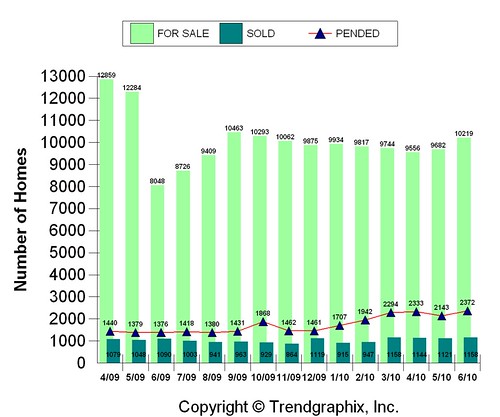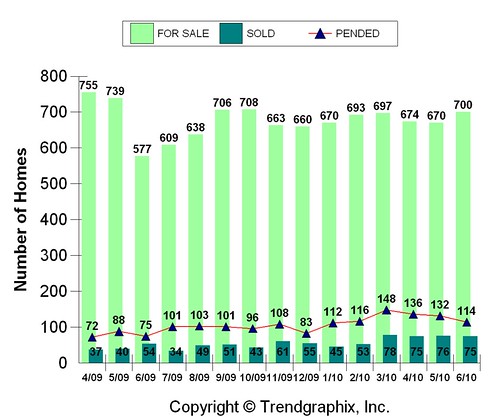Asking Prices Rise Year over Year in 6 out of 7 Election Swing States
With yet another monthly increase, prices are up 2.5% year over year and are on track to rise almost 4% in 2012. Meanwhile, rents – now up 4.8% year over year – still outpacing prices.
The Trulia Price Monitor and the Trulia Rent Monitor are the earliest leading indicators of how asking prices and rents are trending nationally and locally. They adjust for the changing mix of listed homes and therefore show what’s really happening to asking prices and rents. Because asking prices lead sales prices by approximately two or more months, the Monitors reveal trends before other price indexes do. With that, here’s the scoop on where prices and rents are headed.
Good News for Obama: Prices Up 6 in out of 7 Swing States, including Nevada and FloridaPresidential elections are decided in swing states, so this month we’re taking a special look at prices in the 7 states that Real Clear Politics considers “toss-up states” – which means they’re still up for grabs for either candidate. President Obama is vulnerable on housing since many of the Administration’s housing policies designed to help people refinance or keep their homes have fallen short of expectations. But Obama should breathe a sigh of relief: asking prices in 6 of the 7 swing states are up year over year.
| Swing State* |
Y-o-Y % change in asking prices,
September 2012 |
| Nevada |
7.0%
|
| Florida |
6.9%
|
| Colorado |
5.5%
|
| Iowa |
3.2%
|
| Missouri |
2.4%
|
| Virginia |
0.4%
|
| North Carolina |
-0.8%
|
* as categorized by Real Clear Politics, as of October 2.
The two swing states with the biggest year-over-year price increases –Nevada and Florida – had seen huge price declines earlier and lots of foreclosures, so their recent price increases will be especially appreciated by Obama. Among all the swing states, prices declined year over year only inNorth Carolina, and by less than 1%.
What about other states that could still be in play? In addition to the 7 swing states, Real Clear Politics names 8 states “leaning” toward Obama and 3 states “leaning” toward Romney. (All other states are either “likely” or “solid” for one of the candidates.) Of these, prices are falling most in Pennsylvania, which leans toward Obama, and South Carolina, which leans toward Romney. But Michigan and Arizona – which along with Florida, Nevada and California (which is solidly Obama) suffered the most “housing misery” after the bubble burst – have seen big price rebounds over the past year.
| States LeaningToward Obama* |
Y-o-Y % change in asking prices,
September 2012 |
| Michigan |
7.9%
|
| Ohio |
2.7%
|
| Minnesota |
2.1%
|
| Oregon |
1.9%
|
| Wisconsin |
0.7%
|
| New Hampshire |
-0.1%
|
| New Mexico |
-1.5%
|
| Pennsylvania |
-2.4%
|
* as categorized by Real Clear Politics, as of October 2.
| States Leaning Toward Romney* |
Y-o-Y % change in asking prices,
September 2012 |
| Arizona |
18.1%
|
| Indiana |
-0.7%
|
| South Carolina |
-1.9%
|
* as categorized by Real Clear Politics, as of October 2.
In summary: there are 4 states that are tossups or only leaning one way or the other where a severe housing bust led to really miserable housing markets:Nevada, Florida, Michigan and Arizona. President Obama might have been especially vulnerable to criticism about housing in these states. However, all 4 of these states have seen strong price increases year over year, from almost 7% in Florida to 18% in Arizona. And, among the 7 toss-up states, 6 out of 7 saw prices rise. That’s good news for Obama.
National Home Prices On Track to Rise Almost 4% in 2012 – Ending Years of Price DeclinesIn September, asking prices rose 0.5% month over month, and 2.5% year over year. Prices have been stable or rising throughout 2012, and if the year-to-date price trend continues, asking prices will be up almost 4% in 2012 – ending several years of price declines. Nearly three-quarters of large metros – 74 out of 100 – had year-over-year price increases, and even more – 86 out of 100 — had quarter-over-quarter increases, seasonally adjusted.
September 2012 Trulia Price Monitor Summary
| |||
% change in asking prices
|
# of 100 largest metros with asking-price increases
|
% change in asking prices,excluding foreclosures
| |
| Month-over-month, seasonally adjusted |
0.5%
|
(not reported)
|
0.6%
|
| Quarter-over-quarter, seasonally adjusted |
1.6%
|
86
|
1.9%
|
| Year-over-year |
2.5%
|
74
|
3.5%
|
Phoenix Still Sets Pace for Home Price ReboundsAsking prices in Phoenix rose 23.8% year over year in September, making Phoenix by far the biggest price-gainer in the country. What do the 10 metros with the largest price increases have in common? Truth is: not much! Phoenix, Cape Coral – Fort Myers, West Palm Beach and Orlando all had post-bubble price declines of half or more, so these year-on-year increases are a bounceback. In contrast, the price gains in San Jose and Denver are thanks to strong job growth. Prices in Oakland and San Jose are getting an additional lift from the decline in inventory and vacancies in those markets because tighter supply pushes up prices.
Metros with Largest Year-over-Year Asking Price Increases
| |||
| # | U.S. Metro |
Y-o-Y % change in asking prices,
Sept 2012 |
Y-o-Y % change in asking prices,
Jun 2012 |
| 1 | Phoenix, AZ |
23.8%
|
18.1%
|
| 2 | Cape Coral-Fort Myers, FL |
16.7%
|
12.8%
|
| 3 | Warren-Troy-Farmington Hills, MI |
12.0%
|
6.3%
|
| 4 | West Palm Beach, FL |
11.6%
|
9.0%
|
| 5 | San Jose, CA |
10.4%
|
6.8%
|
| 6 | Detroit, MI |
9.1%
|
3.6%
|
| 7 | Oakland, CA |
9.0%
|
1.0%
|
| 8 | Denver, CO |
8.7%
|
6.0%
|
| 9 | Orlando, FL |
8.7%
|
5.0%
|
| 10 | Tucson, AZ |
8.6%
|
0.5%
|
Among the 100 largest metro areas.
Rents Up 4.8% Year over Year, Led by Houston and MiamiIn September, rents rose nationally 4.8% year over year. Among the largest 25 rental markets, rents rose the most in Houston and Miami, where they climbed more than 10% year over year in September. Strong job growth has pushed up rental demand in Houston. Rent increases have cooled the most in San Francisco, from 14.5% in June down to 7.2% in September – which is still plenty high by national standards – but brings much-needed relief to renters in the SF Bay Area.
Metros with Largest Year-over-year Asking Rent Increases
| |||
| # | U.S. Metro |
% change in rents, Y-o-Y , Sept 2012
|
% change in rents, Y-o-Y, June 2012
|
| 1 | Houston, TX |
15.9%
|
6.7%
|
| 2 | Miami, FL |
10.4%
|
9.9%
|
| 3 | Seattle, WA |
9.6%
|
9.7%
|
| 4 | Oakland, CA |
9.2%
|
10.9%
|
| 5 | Denver, CO |
9.0%
|
10.7%
|
| 6 | Philadelphia, PA |
8.3%
|
6.0%
|
| 7 | San Francisco, CA |
7.2%
|
14.5%
|
| 8 | Chicago, IL |
7.0%
|
5.1%
|
| 9 | Boston, MA |
6.7%
|
9.4%
|
| 10 | Minneapolis-St. Paul, MN-WI |
6.0%
|
5.2%
|
Among the 25 largest rental markets.
This month, we’ll be keeping a close eye on the housing markets in the swing states and on housing policy. Stay tuned for the next Trulia Price Monitor and Trulia Rent Monitor, which will be released the day before Election Day, on Monday, November 5 at 10 AM ET.
How did we put this report together? To recap the methodology, the Trulia Price Monitor and the Trulia Rent Monitor track asking home prices and rents on a monthly basis, adjusting for the changing composition of listed homes, including foreclosures provided by RealtyTrac. The Trulia Price Monitor also accounts for the regular seasonal fluctuations in asking prices in order to reveal the underlying trend in prices. The Monitors can detect price movements at least three months before the major sales-price indexes do. Our FAQs provide all the technical details.









